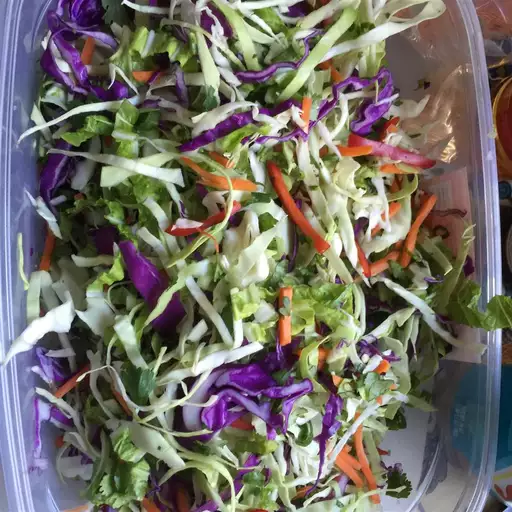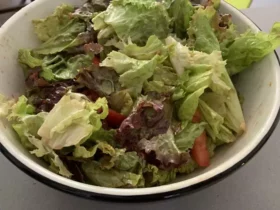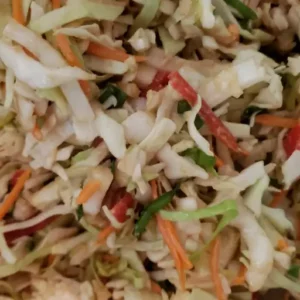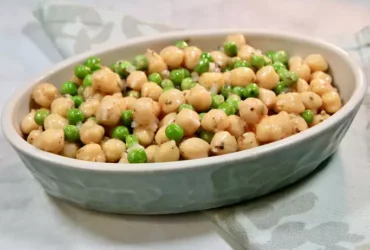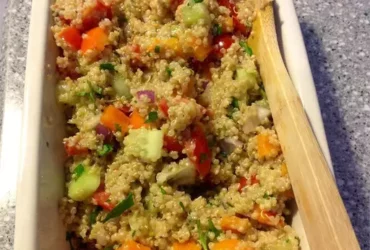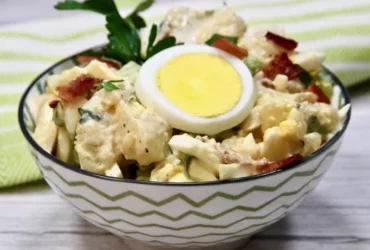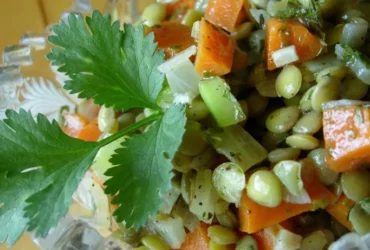Ingredients
Cabbage, Carrots, and Cilantro
The key to crafting an authentic Asian coleslaw lies in selecting ingredients that harmonize with one another, blending flavors and textures that tantalize the taste buds.
Cabbage is a staple component in this recipe, providing a crunchy base that absorbs the flavors of its accompaniments. When choosing cabbage for your slaw, opt for a firm-headed variety such as napa or savoy, which offers a delicate crunch and a subtle sweetness.
Carrots bring a pop of color to the slaw while introducing a satisfying crunch. To prepare them for the recipe, peel and grate the carrots using a box grater or a food processor with the shredding attachment. This ensures an even texture that distributes evenly throughout the salad.
Cilantro, also known as coriander leaves, contributes an unmistakable citrusy flavor to Asian coleslaw. Use fresh cilantro leaves for maximum flavor and aroma, choosing sprigs with bright green coloration and a delicate fragrance.
When combining cabbage, carrots, and cilantro in your slaw, take care to distribute the ingredients evenly, creating a balanced composition that allows each component to shine. Don’t overmix, as this can lead to a soggy or uneven texture.
To amplify the flavors of these essential ingredients, add aromatics such as ginger and garlic to the mix, along with a hint of sweetness from sugar or honey. This blend will evoke the distinct essence of an authentic Asian coleslaw that awakens the senses.
2 cups of shredded napa cabbage
- Napa cabbage is a key ingredient in many Asian-inspired dishes, including this delicious coleslaw recipe.
- The reason for using napa cabbage is due to its unique texture and flavor profile, which sets it apart from other types of cabbage.
What is Napa Cabbage?
- Napa cabbage is a type of Chinese cabbage that originates from the Beijing region in China.
- It has a flat, oval shape with crisp, delicate leaves and a sweet, slightly bitter taste.
- The texture is crunchy and refreshing, making it perfect for salads like coleslaw or as an addition to stir-fries and other Asian dishes.
Why Use Shredded Napa Cabbage in Coleslaw?
- Shredding napa cabbage adds a nice textural element to the slaw, providing a pleasant crunch that complements the softer ingredients like carrots and cilantro.
- The shredded cabbage also allows for easy digestion and absorption of nutrients, making it a healthier option compared to raw or undercooked cabbage.
Key Characteristics of Napa Cabbage
- Crisp, delicate leaves with a sweet, slightly bitter taste
- Flat, oval shape with a compact head
- High in vitamins A and C, as well as fiber and antioxidants
- Pairs well with Asian-inspired flavors like soy sauce, ginger, and sesame oil
Substitutions and Variations
If you can’t find napa cabbage or prefer a different type of cabbage, some alternatives include:
- Savoy cabbage: has a slightly sweeter flavor and a more delicate texture than napa cabbage
- Green cabbage: has a denser, crunchier texture and a stronger flavor than napa cabbage
However, keep in mind that these alternatives may change the overall character of the slaw.
For a milder flavor, you can use less shredded napa cabbage or add more carrots and cilantro to balance it out.
Feel free to experiment with different ratios of ingredients to find your perfect combination!
How to Prepare Napa Cabbage for Coleslaw
- Rinse the napa cabbage under cold water, then dry it thoroughly with a clean towel or salad spinner
- Remove any damaged or wilted leaves from the head of cabbage
- Shred the napa cabbage into thin strips using a sharp knife or mandoline
- In a large bowl, combine the shredded cabbage with your favorite slaw ingredients and dressing
Now that you know more about napa cabbage and how to use it in coleslaw, go ahead and give this recipe a try!
1 cup of grated carrots
A cup of grated carrots is a crucial ingredient in the Asian Coleslaw Recipe, providing a burst of sweet and crunchy texture to the dish. Carrots are rich in vitamins A and K, as well as fiber, making them a nutritious addition to this slaw.
To ensure that the carrots are properly grated, it’s essential to choose fresh and firm carrots for the recipe. Opt for a vegetable peeler or a food processor with a grating attachment to achieve the desired texture. Grate the carrots into fine strips, taking care not to grate them too finely, as this can result in an unappealing texture.
The grated carrots will add a beautiful pop of color and flavor to the slaw, balancing out the tangy dressing and crunchy vegetables. In this recipe, the carrots will be combined with shredded cabbage, chopped cilantro, and sliced red bell pepper to create a refreshing and flavorful slaw that’s perfect for topping noodles, stir-fries, or serving as a side dish.
When it comes to selecting carrots for grating, it’s best to choose medium-sized carrots that are firm but not hard. Avoid using large or small carrots, as these may not grate evenly. If you’re using a food processor with a grating attachment, be sure to grate the carrots in batches to avoid overloading the machine.
Finally, make sure to handle the grated carrots gently to prevent them from becoming mushy or developing off-flavors. Store any leftover grated carrots in an airtight container in the refrigerator for up to three days, and use them as needed in this Asian Coleslaw Recipe.
1/4 cup of chopped cilantro
The ingredient list for this refreshing Asian Coleslaw recipe starts with 1/4 cup of chopped cilantro, a key herb that adds a burst of freshness to the slaw.
Cilantro, also known as coriander or Chinese parsley, is a popular herb commonly used in many Asian and Latin American cuisines. Its flavor profile can be described as pungent, fresh, and slightly citrusy, making it an excellent addition to this slaw recipe.
When selecting cilantro for the recipe, choose fresh bunches with bright green leaves and no signs of wilting or yellowing. The best way to store cilantro is in a sealed container wrapped in a damp paper towel or cloth in the refrigerator, as this will keep it fresh for up to 5 days.
For the slaw recipe, you’ll want to chop the cilantro leaves finely and mix them with shredded cabbage, carrots, red bell pepper, green onions, and a sweet and tangy dressing made from rice vinegar, sugar, soy sauce, grated ginger, garlic, sesame oil, and salt.
Ingredients List:
- 1/4 cup of chopped cilantro
- 2 cups shredded cabbage (green or napa)
- 1 cup peeled and grated carrots
- 1 cup diced red bell pepper
- 1/4 cup thinly sliced green onions (such as scallions or spring onions)
- Dressing ingredients: rice vinegar, sugar, soy sauce, grated ginger, garlic, sesame oil, and salt
The combination of crunchy vegetables and the pungency of cilantro creates a delicious and refreshing slaw that’s perfect as a side dish or topping for your favorite Asian-inspired meals.
Fruits and Nuts
The star ingredients of this delicious Asian Coleslaw Recipe are a variety of colorful fruits and nuts that add natural sweetness, crunch, and texture to the dish.
Here are some key ingredients you’ll need:
Fruits
- Cabbage shredded into thin strips, providing a crunchy base for the slaw
- Carrots, peeled and grated, adding natural sweetness and color
- Red bell peppers, seeded and thinly sliced, introducing a pop of color and sweetness
Nuts
- Cashews, chopped, contributing a rich, buttery flavor and satisfying crunch
- Peanuts, chopped, adding a nutty flavor and texture contrast to the dish
These ingredients work together harmoniously with other key components like:
- Fried onions, adding crunch and a savory flavor
- Sesame seeds, sprinkled on top for added nutty flavor and visual appeal
- Asian-inspired dressing, made with ingredients like soy sauce, honey, rice vinegar, and ginger, tying the entire dish together
This Asian Coleslaw Recipe is a perfect blend of flavors and textures that will tantalize your taste buds and leave you wanting more.
1 cup of diced apple (such as a Granny Smith)
The ingredients for this delicious Asian Coleslaw Recipe are carefully selected to provide a perfect balance of flavors and textures. At the core of the recipe, you’ll need one cup of diced apple.
For this purpose, a Granny Smith apple is preferred due to its firm texture and sweet-tart flavor profile. The crispness of the Granny Smith apple will help maintain the freshness of the slaw throughout its shelf life. You can use other varieties like Fuji or Gala if you prefer a sweeter taste, but be aware that it might alter the overall character of the dish.
When selecting your Granny Smith apple, look for one with minimal blemishes and a firm, vibrant green skin. Avoid choosing apples with soft spots or an unpleasant odor, as these may indicate spoilage or disease.
Once you’ve chosen your perfect Granny Smith apple, peel, core, and dice it into small pieces. A medium-sized apple should yield approximately one cup of diced fruit, which is the ideal amount for this recipe.
The key to achieving the right consistency in the slaw is to balance the crunchiness of the apples with the softness of the other ingredients. For this Asian Coleslaw Recipe, you’ll also need shredded cabbage, carrots, and red bell pepper, among other essential elements. The diced apple will provide a sweet and refreshing contrast to these crunchy components.
When preparing your ingredients, be sure to chop or grate each component finely to ensure even distribution and a harmonious balance of flavors in the finished slaw. This attention to detail is crucial for creating an exceptional coleslaw that complements Asian-inspired dishes perfectly.
1/2 cup of toasted almonds
- Toasted almonds are an essential ingredient in many Asian-inspired dishes, including this delicious Asian coleslaw recipe.
- The 1/2 cup of toasted almonds adds a crunchy texture and nutty flavor to the slaw, which complements the sweetness of the cabbage and carrots perfectly.
- Toasting the almonds brings out their natural oils and intensifies their flavor, making them an ideal addition to this Asian-inspired recipe.
- You can toast the almonds in a 350°F oven for 5-7 minutes or until fragrant and lightly browned, shaking the pan halfway through to ensure even toasting.
- Alternatively, you can also toast the almonds in a dry skillet over medium heat, stirring frequently to prevent burning.
- Once the almonds are toasted, allow them to cool completely before chopping them into smaller pieces to add to your slaw.
- The combination of crunchy toasted almonds, sweet cabbage and carrots, and tangy dressing makes this Asian coleslaw recipe a refreshing and flavorful side dish that’s perfect for any meal or gathering.
Instructions
Prepare the Slaw Base
- To prepare the slaw base, start by shredding a variety of cabbage types such as Napa, Coleman, and green
- Use a box grater or food processor with a shredding attachment to produce uniform shreds. For each type of cabbage, grate about 1/2 cup.
- Mix together the shredded cabbage in a large bowl.
Add in some shredded carrots for added crunch and sweetness:
- Shred 1/2 cup of cabbage using a box grater or food processor with a shredding attachment.
- Mix the grated cabbage with 1/2 cup of grated carrots in a large bowl.
Next, add some thinly sliced red onion for added flavor and texture:
- Thinly slice about 1/4 cup of red onion.
- Mix the grated cabbage, carrots, and thinly sliced red onion together in a large bowl.
Finally, add some chopped cilantro for added freshness:
- Chop about 1/4 cup of cilantro.
- Mix the grated cabbage, carrots, thinly sliced red onion, and chopped cilantro together in a large bowl.
The slaw base is now ready to use as the starting point for your Asian coleslaw recipe. You can customize it by adding other ingredients such as chopped bell peppers, sliced jalapeño, or diced pineapple.
To prepare the slaw, mix together the slaw base with a dressing made from ingredients like soy sauce, rice vinegar, and sesame oil. You can also add some grated ginger for extra flavor.
In a large bowl, whisk together 2 tablespoons of soy sauce
Instructions for making an Asian-style coleslaw recipe often involve combining various ingredients to create a unique and flavorful slaw. In this case, we’re starting with a simple step that sets the tone for the rest of the preparation.
The first instruction is to whisk together 2 tablespoons of soy sauce in English language. This might seem like an unusual task, but it’s actually quite common in culinary contexts. Whisking is a gentle yet effective way to combine ingredients and break down any lumps that may form.
When whisking the soy sauce, it’s essential to use a large bowl to prevent spills and messes. A stainless steel or glass bowl is ideal, as they won’t react with the acidity in the soy sauce. If you’re using a plastic bowl, make sure it’s BPA-free to ensure food safety.
The whisk itself should be a sturdy one that can handle thick mixtures without bending or breaking. An electric whisk or stand mixer will also do the job efficiently, but for small batches like this, a manual whisk is perfectly fine.
Now, back to the task at hand – whisking together 2 tablespoons of soy sauce. This amount may seem insignificant, but it’s an important starting point for our slaw recipe. The soy sauce will add depth and umami flavor to the slaw, balancing out the sweetness from the other ingredients.
As you whisk the soy sauce, pay attention to its consistency. It should be smooth and evenly colored, with no visible streaks or clumps. If it’s too thick, you can thin it out with a small amount of water. Conversely, if it’s too thin, you can add more soy sauce or let it sit for a few minutes to thicken up.
Once the soy sauce is fully whisked and smooth, set it aside for now. We’ll be using it as a base for our coleslaw recipe, which will include shredded cabbage, carrots, cilantro, and a tangy dressing made with rice vinegar and honey.
2 tablespoons of rice vinegar
In the instructions for an Asian Coleslaw recipe, using a specific ingredient measurement such as 2 tablespoons of rice vinegar can be crucial to achieving the desired taste and texture.
Rice vinegar, in particular, has a distinct flavor profile that complements various ingredients commonly found in Asian cuisine, including vegetables, proteins, and seasonings.
When incorporating rice vinegar into a recipe, it is essential to consider its impact on the overall balance of flavors. Too much or too little can significantly alter the taste experience, potentially affecting the dish’s appeal to consumers.
For the purpose of this discussion, we’ll assume that 2 tablespoons of rice vinegar is part of a larger ingredient list for an Asian Coleslaw recipe. This measurement represents just one aspect of the preparation process and will likely be combined with other components, such as shredded vegetables, protein sources (e.g., chicken or tofu), nuts, and seasonings.
When working with ingredients like rice vinegar in recipes, it is not uncommon for variations to occur due to factors such as differences in personal taste preferences, the quality of individual ingredients, and even regional influences on cuisine. This means that while using 2 tablespoons of rice vinegar may be suitable for one recipe or chef, another person might choose a different measurement or altogether opt for an alternative ingredient.
Understanding how various elements like rice vinegar interact within recipes requires some knowledge about the fundamental principles of culinary preparation and flavor combination. For instance, knowing which ingredients are best suited to complement each other based on factors such as sweetness, sourness, saltiness, and umami can help create harmonious flavors in a dish.
When working with an Asian Coleslaw recipe that includes rice vinegar, it’s also worth noting the potential for ingredient substitution or modification. In some cases, alternatives to rice vinegar might be used depending on the specific flavor profile desired or ingredients readily available. For example, other vinegars like balsamic or apple cider can have distinct flavor profiles compared to rice vinegar and could potentially enhance certain aspects of a dish.
Ultimately, using 2 tablespoons of rice vinegar as part of an Asian Coleslaw recipe is just one component of the culinary process, and its significance stems from its ability to contribute to an overall taste experience that complements other ingredients. This highlights the importance of considering various factors when preparing recipes to create harmonious flavors and textures that cater to individual preferences.
1 tablespoon of honey
When it comes to following instructions for recipes, especially those that require precise measurements like cooking or baking, clear and concise language is crucial.
A common measurement in many recipes, including this Asian Coleslaw Recipe, is the tablespoon (tbsp). To clarify, one tablespoon of honey would be equivalent to:
- 3 teaspoons
- 15 milliliters (mL)
In the context of this recipe, using honey adds a rich and distinct flavor profile. The sweetness from the honey balances out the savory flavors in the coleslaw.
To make the best use of these instructions, it is essential to remember that substituting ingredients can greatly affect the final product’s taste. If you choose to substitute honey with another sweetener, adjust the amount accordingly.
1 teaspoon of grated ginger
In culinary settings, instructions are vital for guiding individuals through various cooking processes and techniques. One common method for expressing measurements is using a combination of words and numbers, as seen with “1 teaspoon.” However, this format may not be universally clear due to variations in measurement units across different cultures.
For the purpose of clarity and precision, it’s recommended to use a more detailed approach when describing quantities, such as specifying the exact ingredient being measured (in this case, ginger). This might include phrases like “1 teaspoon of freshly grated ginger” or “1 teaspoon of finely chopped fresh ginger,” which provide additional context.
Grating the ginger can be an important step in releasing its natural oils and flavor compounds. Using the right tool for grating, such as a fine grater or microplane, can significantly impact the texture and quality of the final product.
In the context of the Asian Coleslaw Recipe, the use of 1 teaspoon of grated ginger serves to add a distinct flavor dimension. Ginger has natural properties that can aid in digestion and provide a cooling sensation when consumed.
For individuals who may not be familiar with using fresh ginger in cooking, it’s worth noting that it’s essential to handle it safely to avoid any potential risks. Fresh ginger should be stored in the refrigerator to prevent spoilage and contamination, and it’s recommended to wash it thoroughly before use.
The combination of 1 teaspoon of grated ginger with other ingredients in the Asian Coleslaw Recipe can create a harmonious balance of flavors and textures that are characteristic of traditional Asian cuisine. This dish is an excellent example of how careful attention to measurements and techniques can lead to the creation of delicious and authentic culinary experiences.
In conclusion, instructions like “1 teaspoon” are crucial for guiding cooks through various recipes and cooking processes. By being specific about ingredients and measurements, individuals can ensure that their dishes turn out as intended and provide accurate representations of traditional cuisine.
Salt and pepper to taste
To make an Asian Coleslaw recipe that’s both flavorful and refreshing, it’s essential to follow clear instructions when preparing the dish. Salt and pepper are commonly used seasonings, but their application requires careful attention to bring out the best flavors in your coleslaw.
First, understand that salt enhances flavors while suppressing bitterness. Pepper adds depth without overpowering other ingredients. When instructed to “salt and pepper to taste,” it means adding these seasonings until they blend with the other ingredients harmoniously. This process is called seasoning.
To apply this instruction effectively, follow a few guidelines: Start with a light touch when sprinkling salt over your coleslaw. You can always add more salt later if needed, but removing excess salt once it’s been added is challenging. Pepper can be applied in a similar manner; start lightly and adjust as desired.
When combining multiple ingredients, including those with strong flavors like fish sauce or soy sauce (common in Asian Coleslaw recipes), use your judgment on how much seasoning to add initially. This will help prevent overpowering the other tastes and textures within your dish.
Some common guidelines for seasoning with salt and pepper include: Salt: Use about 1/4 teaspoon of fine-grained or kosher-style salt per cup of slaw mix; Pepper: Sprinkle a small amount, perhaps around 1/8 teaspoon per cup of slaw mix, as the heat from pepper can easily overpower other flavors.
It’s also worth noting that different types of coleslaw, including Asian styles, may have unique ingredient profiles and thus might require variations in salt and pepper application. Feel free to experiment with these seasoning levels to find what works best for your personal taste preferences and the specific flavors in your slaw mix.
In summary, “salt and pepper to taste” is more than a simple instruction; it’s an invitation to develop your own culinary style by mastering the art of balancing flavors in your cooking. By starting with small amounts of these seasonings and adjusting as needed, you’ll become proficient at creating dishes that delight both your palate and your guests.
Mix in the Slaw Ingredients
To make the delicious Asian Coleslaw, follow these instructions carefully.
Slaw Ingredients
- Cabbage: This will be our base ingredient for the slaw. We’ll use a mix of green and red cabbage for a colorful look.
- Cilantro: Chopped cilantro adds a fresh flavor to the slaw, but feel free to omit if you’re not a fan of the herb.
- Carrots: Grated carrots add a nice crunch and sweetness. You can use purple or regular carrots for this recipe.
- Cucumber: Thinly sliced cucumber adds moisture and freshness to the slaw.
- Sesame Seeds: These seeds provide nutty flavor and crunchy texture.
Mixing Slaw Ingredients
To mix in the slaw ingredients, follow these steps:
- In a large bowl, combine 1 cup of shredded cabbage, 1/2 cup of grated carrots, and 1/4 cup of chopped cilantro. Stir until well combined.
- Add 1 cup of thinly sliced cucumber to the bowl and stir gently to avoid bruising the cucumber slices.
- Pour in 2 tablespoons of Asian dressing (such as soy sauce or rice vinegar-based) into the bowl and toss to coat the slaw ingredients evenly.
- Sprinkle 1 tablespoon of sesame seeds over the top of the slaw mixture and gently fold them in with a spatula.
Final Touches
To complete our Asian Coleslaw, we’ll add some finishing touches:
- Garnish the slaw with chopped scallions or cilantro for extra flavor and visual appeal.
- Adjust seasoning by adding more dressing, sesame seeds, or other ingredients to taste.
Add the cabbage mixture, carrots, cilantro, apple, and almonds to the bowl with the slaw base
When it comes to making a delicious and refreshing Asian Coleslaw, following clear instructions is key to achieving perfect results. Here’s what you need to do:
Step 1: Add the cabbage mixture
To begin, take your cabbage mixture, which consists of shredded red cabbage, green cabbage, or a combination of both, and add it to the bowl with the slaw base. Make sure to distribute it evenly so that all the ingredients are well combined.
Step 2: Add carrots
Next, add the grated or spiralized carrots to the bowl. You can use regular carrots or colored carrots for added visual appeal. Carrots add a sweet and crunchy texture to the slaw, so don’t be shy with them!
Step 3: Add cilantro
Chopped cilantro is a staple in many Asian dishes, including coleslaw. Sprinkle the chopped cilantro over the top of the cabbage mixture and carrots. Make sure to use fresh cilantro for the best flavor.
Step 4: Add apple
Thinly slice or dice an apple, such as a Granny Smith or Red Delicious, and add it to the bowl. Apples add natural sweetness and texture to the slaw. You can also use other types of apples, like Fuji or Gala.
Step 5: Add almonds
Crispy almonds are the perfect finishing touch for this Asian Coleslaw recipe. Sprinkle sliced or chopped almonds over the top of the slaw and mix well to distribute them evenly.
Tips and Variations
- For an extra crunch, add some toasted sesame seeds or chopped pecans to the slaw.
- To make this recipe more substantial, add cooked chicken, shrimp, or tofu.
- Experiment with different types of cabbage, such as Savoy or Napa cabbage, for a unique flavor and texture.
Conclusion
By following these simple steps and adding the necessary ingredients to the bowl, you’ll be on your way to creating a delicious and refreshing Asian Coleslaw that’s perfect for topping tacos, grilled meats, or veggies. Enjoy!
Toss until everything is well combined
To make this delicious Asian Coleslaw Recipe, it’s essential to follow some precise instructions that will guide you through the process of creating a unique and tasty side dish.
The first step involves shredding the cabbage into thin strips, making sure to remove any excess water from the cabbage leaves to prevent the slaw from becoming too soggy. This can be achieved by wrapping the shredded cabbage in a clean kitchen towel or cheesecloth and giving it a good squeeze.
Next, peel and grate the carrots, taking care not to grate them too finely as this can make the slaw look unappealing. Slice the green onions thinly, making sure to only use the white and light green parts of the onions for their mild flavor.
Mix all the prepared vegetables in a large bowl, ensuring they’re evenly distributed throughout. Add the chopped fresh cilantro or scallions on top, depending on your preference for a pop of color and freshness.
Now, it’s time to prepare the dressing that will bring everything together. In a separate bowl, whisk together the soy sauce, honey, rice vinegar, grated ginger, sesame oil, salt, and black pepper until well combined. Taste the dressing as you go, adjusting the seasoning to suit your taste preferences.
Drizzle the prepared dressing over the vegetables in the large bowl, making sure each piece is coated with a generous amount of the sauce. Toss until everything is well combined, taking care not to over-mix the slaw, which can make it too soggy or unappetizing.
Cover the bowl with plastic wrap and refrigerate for at least 30 minutes to allow the flavors to meld together and the vegetables to absorb the dressing. Before serving, give the slaw a good toss again to redistribute the ingredients.
Tips and Variations
Customize the Slaw
To make this delicious Asian Coleslaw recipe truly yours, consider these Tips and Variations to customize it according to your taste preferences.
Main Ingredients: The core ingredients are shredded cabbage, carrots, green onions, and cilantro. These can be adjusted in quantity or replaced with alternative vegetables like napa cabbage, bok choy, or even red bell pepper for added crunch and color.
Dressing: The Asian-inspired dressing is the heart of this slaw. You can adjust the balance between sweet, sour, salty, and umami flavors to suit your taste. Consider using more or less soy sauce, adding a drizzle of rice vinegar, or substituting with other Asian-style dressings like gochujang or sesame oil-based dressings.
Add Some Heat: Spice up your slaw by incorporating hot peppers like jalapeño or serrano into the mix. You can also use red pepper flakes to add a subtle kick of heat.
Crunchy Texture: Adding some crunchy texture will make this slaw even more exciting. Try adding popped rice, crispy fried onions, toasted nuts like peanuts or almonds, or even crumbled crackers for added crunch.
Creamy Element: Balance out the crunch by adding a creamy element to your slaw. You can use sour cream, Greek yogurt, or even crumbled ranch dressing to add richness and depth of flavor.
Add Fresh Herbs: Pickled ginger, chopped scallions, or cilantro are all great additions to give your slaw an extra boost of freshness. Experiment with different herbs like basil, mint, or lemongrass for a unique twist.
For a spicy kick, add some diced jalapeño peppers or sriracha
To give your Asian Coleslaw a spicy kick, you can add some diced jalapeño peppers or sriracha to the mix.
For an extra layer of flavor, try adding some grated ginger or garlic to the slaw. This will not only add depth but also help to balance out the sweetness from the red cabbage.
If you’re looking for a creamier version, substitute some or all of the mayonnaise with Greek yogurt or sour cream. This will not only reduce the calorie count but also add a tangy twist to the slaw.
Experiment with different types of cabbage, such as napa cabbage or savoy cabbage, for a varying texture and flavor profile.
To make your Asian Coleslaw more substantial, toss in some chopped carrots, bell peppers, or zucchini. This will not only add fiber but also create a colorful and visually appealing dish.
For a vegan version, replace the fish sauce with a mixture of soy sauce and maple syrup. This will maintain the umami flavor while keeping it plant-based.
Try adding some chopped fresh herbs like cilantro or mint to give your slaw an extra burst of freshness.
To make ahead, prepare all the ingredients up to a day in advance. Then, simply assemble and refrigerate until serving time.
To make it more substantial, add some cooked noodles or chickpeas
To take your Asian coleslaw recipe to the next level, consider adding some protein-rich ingredients like cooked noodles or chickpeas to make it more substantial. Here are some tips and variations to try:
- Adding Noodles: Cooked noodles can add a nice texture and bulk to your slaw. Try using rice noodles, soba noodles, or even udon noodles for a different twist. Simply cook the noodles according to the package instructions and toss them with the coleslaw mix.
- Adding Chickpeas: Chickpeas can add protein and fiber to your slaw, making it a more filling side dish. Rinse and drain a 15-ounce can of chickpeas and toss them with the coleslaw mix. You can also roast some chickpeas in the oven with some oil and soy sauce for added flavor.
- Spicing it up: If you like spicy food, try adding some red pepper flakes or sriracha to your slaw. This will give it an extra kick of heat that pairs well with the Asian-inspired flavors.
- Adding Crunch: To add more texture and crunch to your slaw, try tossing in some chopped nuts or seeds like cashews, almonds, or sesame seeds. You can also use crispy fried shallots for added flavor and crunch.
- Make it a Main Course: If you’re looking for a main course option, consider adding grilled chicken or tofu to your slaw. This will make it more substantial and filling for a quick weeknight dinner. Simply grill the protein of your choice and toss it with the coleslaw mix.
- Make it Vegan-Friendly: If you want to make your slaw vegan-friendly, simply omit the animal-based ingredients like honey or fish sauce. You can substitute them with plant-based alternatives like maple syrup or tamari soy sauce for added flavor.
Experiment with different types of cabbage or other crunchy vegetables
Tips and Variations: Experiment with different types of cabbage or other crunchy vegetables to add variety to your Asian coleslaw.
Cabbage Options
- Napa Cabbage: A popular choice for slaws, Napa cabbage has a delicate flavor and tender texture.
- Green Cabbage: More robust in flavor than Napa cabbage, green cabbage adds a nice crunch to the slaw.
- Savoy Cabbage: With its loose-leaf texture and slightly sweet flavor, savoy cabbage is a great choice for adding depth to your slaw.
Other Crunchy Vegetables
- Carrots: Grate or shred carrots and add them to the slaw for a pop of color and extra crunch.
- Red Cabbage: Add some sweetness with thinly sliced red cabbage.
- Radishes: Thinly slice or dice radishes and add them to the slaw for an spicy kick.
Protein Options: Consider adding protein sources like cooked chicken, tofu, or tempeh to make your Asian coleslaw a more substantial side dish.
Variations by Region
- Hawaiian-Style: Add some diced pineapple and chopped macadamia nuts for a tropical twist on the classic slaw.
- Chinese-Style: Substitute soy sauce with rice vinegar and add diced scallions for an authentic Chinese flavor.
Feel free to experiment with different combinations of vegetables, protein sources, and seasonings to create your own unique Asian coleslaw recipe!
- Best Lusha Alternatives for 2025 - April 22, 2025
- Best Overloop Alternatives for 2025 - April 22, 2025
- Best 6sense Alternatives for 2025 - April 22, 2025

